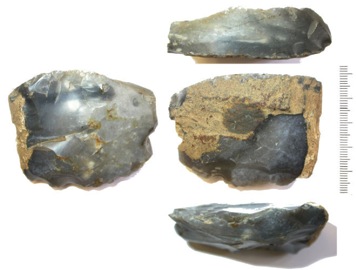
Trampling during occupation of the site;
Post depositional movement in the sediment;
‘plough damage’ flints from cultivated fields often have flakes removed by farming machinery and can be confused with ‘real’ stone tools
Rough handling during excavation, e.g.. trowel damage;
Storage conditions, e.g.. 'box damage' (if flints are kept loose in a box they can rub together often causing fractures along the edges.
"Edge damage: The removal of material from edges by natural processes, spontaneous retouch, soil movement, trampling etc." as opposed to, "Edge wear: The removal of material from edges by flaking and/or rounding by use." (Grace 1989, 114) It is impossible to reliably tell the difference between edge damage and edge wear without using special techniques such as use-wear analysis.(see Grace 1989, Grace1990a, Grace 1993., Kamminga 1982 , Keeley 1980., Semenov 1964)